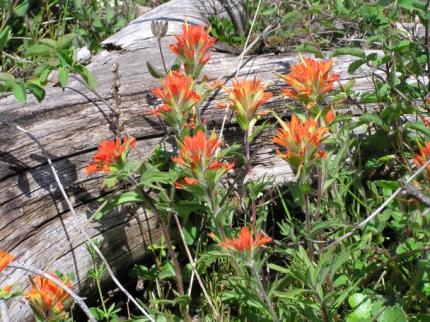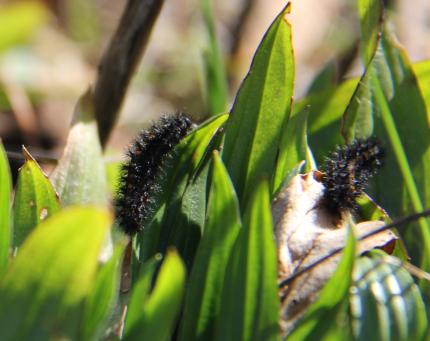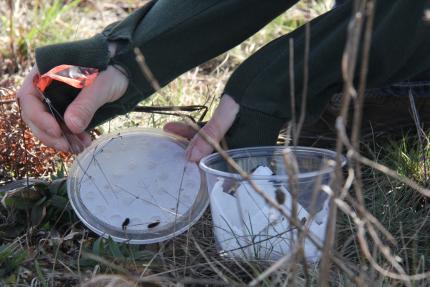Moderate-
High
Taylor’s checkerspot is a Pacific Northwest endemic butterfly. It is currently restricted to a small scattering of 8 populations in Washington, a single population in British Columbia, and 2 populations in Oregon. The decline of this butterfly has accompanied the loss of open, prairie and grassland habitats.
Description and Range
Physical description
Taylor’s checkerspot is a medium-sized butterfly with a striking checkered pattern of orange to brick red, black, and cream. It is a subspecies of Edith’s checkerspot; three additional Edith’s checkerspot subspecies occur within Washington (colonia, beani, and edithana).
Ecology and life history
The Taylor’s checkerspot is dependent on prairie and grassland habitats. It also occupies coastal bluffs and dunes as well as small forest openings (balds).

The species is currently restricted to a small scattering of eight populations in Washington, a single population in British Columbia, and two populations in Oregon. Like other butterflies that rely on these habitats in the Willamette Valley-Puget Trough-Georgia Basin ecosystem, it has declined dramatically due to widespread habitat degradation and loss of prairie-oak ecosystems from development, invasive species, and loss of beneficial disturbance mechanisms. Habitat enhancement efforts for Taylor's checkerspot since 2006 have been significant, however, the amount of fully-restored habitat relative to need is low, and the configuration of habitat remains fragmented and isolated.
Females emerge in the spring and lay eggs on host plants of the family Scrophulariaceae, which are often specific to sites (or populations); these include harsh paintbrush (Castilleja hispida), marsh speedwell (Veronica scutellata), American brooklime (V. beccabunga), and non- natives including plantains (Plantago lanceolate and P. major) and thyme-leaved speedwell (V. serpyllifolia ssp. serpyllifolia). When the caterpillars emerge, they depend on these primary host species for food until early summer, when they enter an inactive diapause stage (a state of suspended development).
Emerging from a diapause in late winter, the caterpillars feed more broadly on the primary hosts and other post-diapause food plants that may be available, including sea blush (Plectritis congesta), blue-eyed Marys (Collinsia parviflora and C. grandiflora), and dwarf owl-clover (Triphysaria pusilla).

Geographic range
The Taylor’s checkerspot was historically found in open, prairie and grassland habitats from southeastern Vancouver Island, British Columbia, south through the Puget Trough in western Washington, and into the southern Willamette Valley in Oregon. Its distribution included 45 documented locations in Washington from the San Juan Islands south to the Cowlitz River in Lewis County.
Today, the butterfly is restricted to 11 known populations: eight in Washington, one in British Columbia, and two in Oregon.
For a map of worldwide distribution and other species’ information, check out NatureServe Explorer.
Climate vulnerability
Sensitivity to climate change
Moderate-
High
Taylor's checkerspot sensitivity is driven by increased temperature, increased frequency of temperature and precipitation extremes, and drought. Additionally, montane populations are affected by reduced snowpack and earlier snowmelt which creates highly exposed, novel conditions for overwintering larvae, likely increasing mortality, and contributes to habitat degradation by hastening conifer encroachment in the butterfly's open, grassland habitat. Sea level rise paired with storm surges and windy conditions can inundate or cause significant sediment alteration in low-lying coastal habitats of TC. Storm events and sea level rise can cause larval mortality and contribute to temporary or permanent habitat loss due to inundation, burial of host and forage plants, and loss of anchoring substrate and woody debris required for vegetation establishment. Recent storm events have been observed inundating occupied TC habitat, followed by loss of host plants in these areas. Population numbers vary annually in response to variable weather because TCs exhibit physiological and indirect (i.e., habitat) sensitivity to temperature and precipitation. Temperature influences butterfly behavior (e.g., mating, foraging, egg-laying time), adult life span, and larval development. Cool, wet spring conditions limit adult activity and therefore fecundity. Warming temperature may also affect phenological timing between TC and key plant species (host and nectar plants), causing low availability of nectar resources and pre-mature desiccation of larval forage, leading to reduced fitness or starvation of adults or larvae. Taylor's checkerspot is also sensitive to rain, and extreme downpours could cause severe population declines by washing away eggs and larvae and limiting adult flight.
Exposure to climate change
Moderate-
High
- Increased temperatures
- Drought
- Extreme precipitation events
- Increased invasive weeds
- Increased frequency of temperature and precipitation extremes
- Reduced snowpack
- Earlier snowmelt
- Later first frost
- Sea level rise and storm surge
- Increased invasive weeds
Conservation
Taylor’s checkerspot was listed as an endangered species by the Washington State Fish and Wildlife Commission in 2006, the Committee on the Status of Endangered Wildlife in Canada in 2011, and the U.S. Fish and Wildlife Service in 2013. When the Washington Fish and Wildlife Commission listed this butterfly as endangered, it was known to occur on 10 Washington sites in Clallam, Pierce, and Thurston counties.
In the decade that has passed since the original Washington status review, extirpation of the butterfly has been observed on seven of the 10 sites. Also during this decade, searches continued for Taylor's checkerspot in previously unsurveyed landscapes on the Olympic Peninsula, and five new sites were located within the Olympic National Forest. Despite continued exploratory searches to locate additional populations, none have been found since 2009.
Conservation Threats and Actions Needed
Due to the small number of mostly isolated populations, continued threats to habitat from invasive native and non-native plants, and vulnerability to severe weather events, Taylor's checkerspot remains threatened with extinction throughout its range in Washington. See the Climate vulnerability section above for details about threats posed to this species by climate change.
- Invasive and other problematic species
- Threat: Invasive plants, those currently here, and many yet to come in the future, out-compete native grassland species, and otherwise make habitat unsuitable.
- Actions Needed: Using herbicide, fire, and mechanical methods to restore native prairie. Planting/seeding native prairie species.
- Threat: Trees and shrubs encroaching on habitat in forest matrix sites, primarily within Clallam County, due to long-term fire suppression.
- Action Needed: Remove invading trees and shrubs.
- Fish and wildlife habitat loss or degradation.
- Threat: Only a few, small and disjunct populations remain in the South Sound region.
- Action Needed: Reintroduce at restored prairie sites.
- Threat: Military training on Joint Base Lewis-McChord that is poorly timed or placed and significantly impacts populations.
- Action Needed: Develop best management practices for areas occupied by butterfly within Joint Base Lewis-McChord.
Our Conservation Efforts

The Sustainability in Prisons Project
WDFW participates in this project, which is a partnership founded by The Evergreen State College (TESC) and Washington State Department of Corrections (DOC). With critical input from many additional partners such as WDFW, TESC and DOC develop and deliver a wide range of science, sustainability and environmental education programs in all 12 Washington State prisons. Learn more about this project and watch a film that shares the experiences of formerly incarcerated partners who have made a significant contribution through their efforts to help perpetuate imperiled species, such as the Taylor’s checkerspot butterfly. This film was made prior to the COVID-19 pandemic.
Resources
References
Grosboll, D. N. 2011. Taylor’s Checkerspot (Euphydryas editha taylori) oviposition habitat selection and larval hostplant use in Washington State. M.E.S. Thesis, The Evergreen State College, Olympia. 77 pp.
Page, N., P. Lilley, J. Heron, and N. Kroeker. 2009. Distribution and habitat characteristics of Taylor’s Checkerspot on Denman Island and adjacent areas of Vancouver island (2008). Report prepared for British Columbia Ministry of Environment and Parks Canada. Raincoast Applied Ecology, Vancouver. 32 pp.
Severns, P. M. and A. D. Warren. 2008. Selectively eliminating and conserving exotic plants to save an endangered species from local extinction. Animal Conservation 11:476-483.
Severns, P. M and D. Grosboll. 2010. Patterns of reproduction in four Washington State populations of Taylor’s checkerspot (Euphydryas editha taylori) during the spring 2010. Report submitted to the Nature Conservancy. 81 pp.
Stinson, D. W. 2005. Washington State status report for the Mazama pocket gopher, streaked horned lark, and Taylor’s Checkerspot. Washington Department of Fish and Wildlife, Olympia, Washington. 129 pp.
USFWS. 2013. Endangered and threatened wildlife and plants; determination of endangered status for Taylor’s Checkerspot butterfly and threatened status for the streaked horned lark; final rule. Federal Register 78 (192):61451-61503.
WDFW Publications
Status reports
- Periodic Status Review for Taylor's Checkerspot (2016)
- Washington State Status Report for the Mazama Pocket Gopher, Streaked Horned Lark, and Taylor's Checkerspot (2005)


